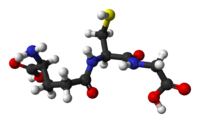
Photo from wikipedia
The mechanisms by which neurons maintain redox homeostasis, disruption of which is linked to disease, are not well known. Hydrogen peroxide, a major cellular oxidant and neuromodulator, can promote reversible… Click to show full abstract
The mechanisms by which neurons maintain redox homeostasis, disruption of which is linked to disease, are not well known. Hydrogen peroxide, a major cellular oxidant and neuromodulator, can promote reversible oxidations of protein thiols but the scope, targets, and significance of such oxidations occurring in neurons, especially in vivo, are uncertain. Using redox phenylarsine oxide (PAO)-affinity chromatography, which exploits the high-affinity of trivalent arsenicals for protein dithiols, this study investigated the occurrence of reducible and, therefore, potentially regulatory, protein disulfide bonds in Triton X-100-soluble protein fractions from isolated nerve-endings (synaptosomes) prepared from rat brains. Postmortem oxidations of protein thiols were limited by rapidly freezing the brains following euthanasia and, later, homogenizing them in the presence of the N-ethylmaleimide to trap reduced thiols. The reducible disulfide proteome comprised 5.4% of the total synaptosomal protein applied to the immobilized PAO columns and was overrepresented by pathways underlying ATP synaptic supply and demand including synaptic vesicle trafficking. The alpha subunits of plasma membrane Na+, K+-ATPase and the mitochondrial ATP synthase were particularly abundant proteins of the disulfide proteome and were enriched in this fraction by 3.5- and 6.7-fold, respectively. An adaptation of the commonly used “biotin-switch” method provided additional support for selective oxidation of thiols on the alpha subunit of the ATP synthase. We propose that reversible oxidations of protein thiols may underlie a coordinated metabolic response to hydrogen peroxide, serving to both control redox signaling and protect neurons from oxidant stress.
Journal Title: Neurochemical Research
Year Published: 2020
Link to full text (if available)
Share on Social Media: Sign Up to like & get
recommendations!